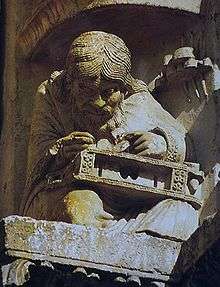School of Chartres

During the High Middle Ages, Chartres Cathedral operated a famous and influential cathedral school, an important center of scholarship. It developed and reached its apex in the 11th and 12th centuries. It was a transitional period, at the very start of the Latin translation movement and right before the spread of medieval universities, which eventually superseded cathedral schools and monastic schools as the most important institutions of higher learning in the Latin West.[1]
In the early 11th century, (c. 1020), Bishop Fulbert established Chartres as one of the leading schools in Europe. Although the role of Fulbert himself as a scholar and teacher has been questioned, perhaps his greatest talent was as an administrator, who established the conditions in which the school could flourish.[2]
Great scholars were attracted to the cathedral school, including Bernard of Chartres, Thierry of Chartres, William of Conches, and the Englishman John of Salisbury. These men were at the forefront of the intense intellectual rethinking that culminated in what is now known as the twelfth-century renaissance, pioneering the Scholastic philosophy that came to dominate medieval thinking throughout Europe.
The teaching in monastic and cathedral schools was typically based on the traditional seven liberal arts, including the trivium (study of logic, grammar and rhetoric) and the quadrivium (arithmetic, geometry, music, and astronomy). There were, however, differences among the schools on the emphasis given for each subject. The Chartres school placed special emphasis on the quadrivium (the mathematical arts) and on natural philosophy.[1]
The school of Chartres' greatest period was the first half of the twelfth century.[1] At Chartres, however, masters lacked the relative autonomy that was developing around the schools of Paris and the small city did not support the large number of students that were found at Paris.[3] By the later 12th century the status of the school was on the wane. It was gradually eclipsed by the newly emerging University of Paris, particularly at the School of the Abbey of St Victor (the 'Victorines').
References
- 1 2 3 Natural Philosophy at School and University, (Lecture 18), in Lawrence M. Principe (2002) History of Science: Antiquity to 1700. Teaching Company, Course No. 1200
- ↑ Loren C. MacKinney, Bishop Fulbert and Education at the School of Chartres, Univ. of Notre Dame Indiana, 1956
- ↑ Southern, R. W. (1982). "The Schools of Paris and the School of Chartres". In Benson, Robert L.; Constable, Giles; Latham, Carol D. Renaissance and Renewal in the Twelfth Century. Cambridge, MA: Harvard University Press. pp. 113–137. ISBN 0-674-76086-7.
Bibliography
- Edouard Jeauneau, Rethinking the School of Chartres, Toronto: University of Toronto Press, 2009.
External links
- The School of Chartres in A History of Western Philosophy Vol. II / by Ralph McInerny